MEKONG: A river in chains (On going)
The Mekong ("Mother of Water" in Laotian) is the lifeblood of Southeast Asia. The river runs for 4 thousand kilometres between the narrow gorges of Tibet through the mountains of Burma and Laos, taking force through the plains of Thailand and Cambodia, to flow into the immense delta in Vietnam and into the South China Sea. In its waters live 1000s of species of fish, which are integral in feeding over 60 million people. Stories and traditions tell of a harmony between the people of Indochina and the Mother of Water.
Today, thirty-nine mega-dams have been planned along the river by riparian states. Colossal power plants, some already under construction, could fragment natural environments and have significant impacts throughout the region. Eleven dams have been scheduled in the Laotian-Cambodian section alone, built by Thai, Malay, Chinese and Vietnamese companies. Laos, the poorest of the states in the region, has declared that its goal is to become the "battery of Southeast Asia”.
None of these constructions have been carried out with a prior independent environmental impact assessment.
This selection of pictures tells of the impact of these omissions on the environment, on people, and on food security in the entire region.
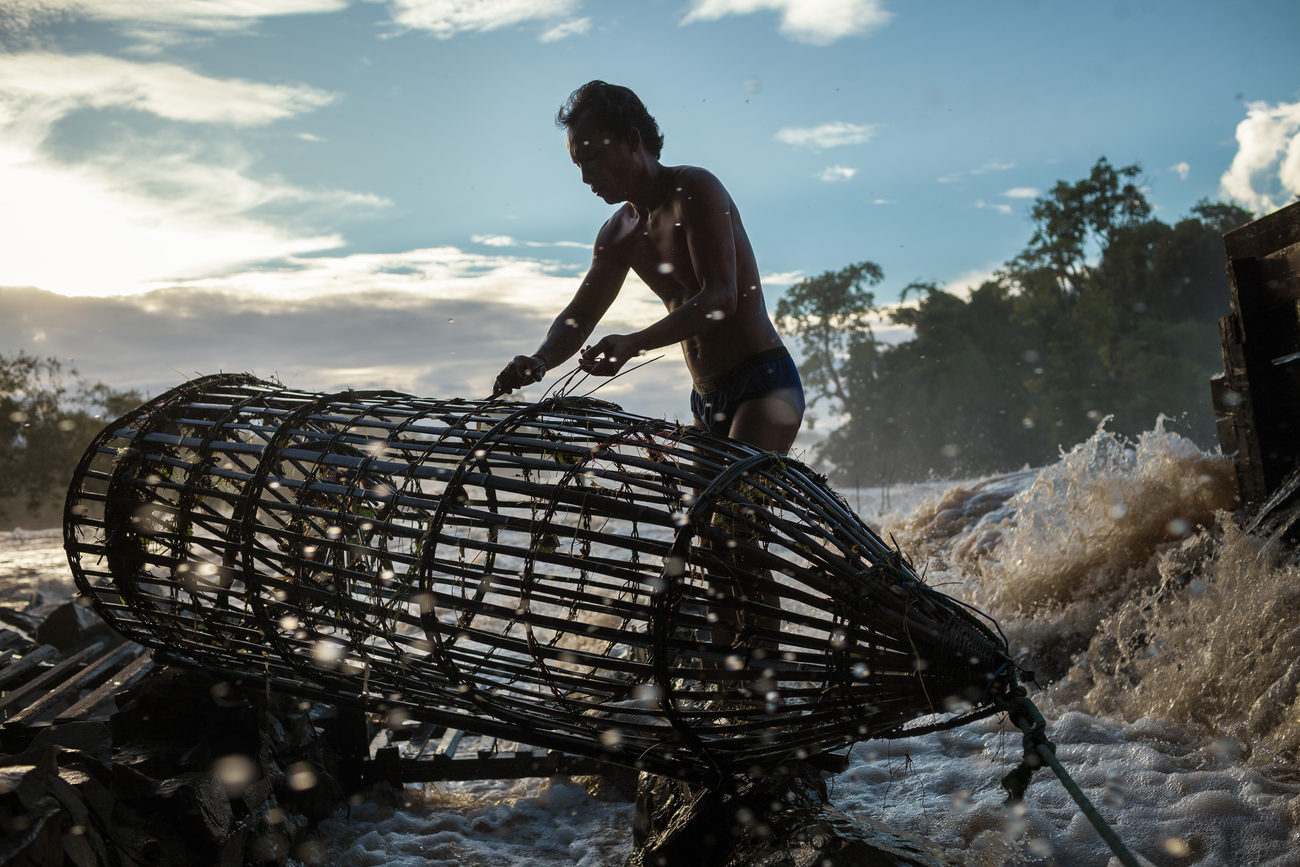
Mekong: a river in chains
August 04, 2013 - Champasak (Laos). A fisherman mends his Ly trap at the Khone Phapheng falls, the location designated for the construction of the Don Sahong Dam. Experts say that the construction of the dam will put at risk the ecological integrity of the Lower Mekong as a whole. In particular, it will have a severe impact on the endangered giant catfish, other fish species — some of them unique to the Mekong — and the Irrawaddy dolphin, which has found a natural habitat just two kilometers from the construction site and is already critically endangered. © Thomas Cristofoletti / Ruom
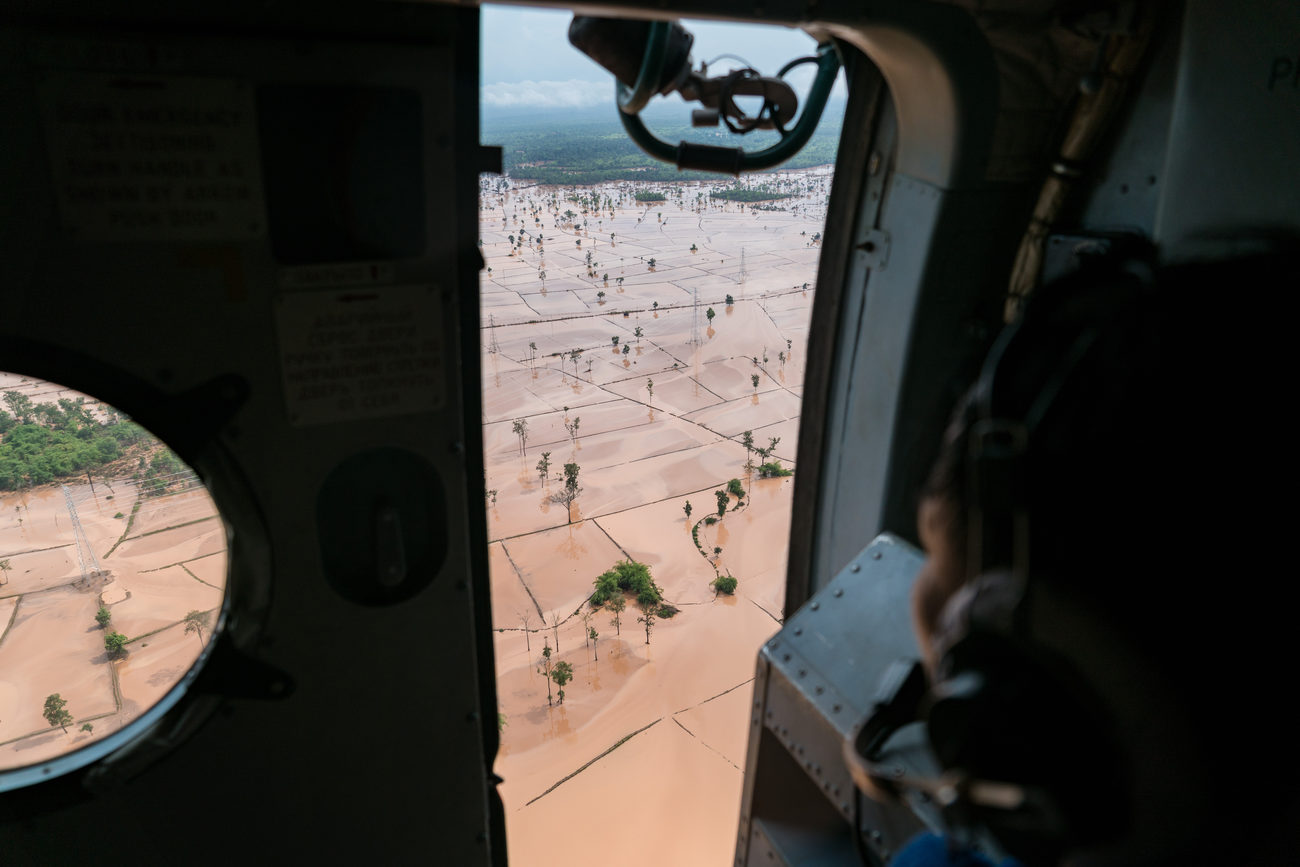
Mekong: a river in chains
August 06, 2018 - Attapeu (Laos). An army helicopter brings food supplies to the remote village of Bane Pindong, flying over one of the affected areas by the fury of the floods caused by the failure of an auxiliary dam of the Xe-Pian Xe-Namnoy hydropower project. 10 days after the accident, most of the villages were still cut off and only reachable by air or after a dangerous drive by 4x4 vehicles or tractors. © Thomas Cristofoletti / Ruom
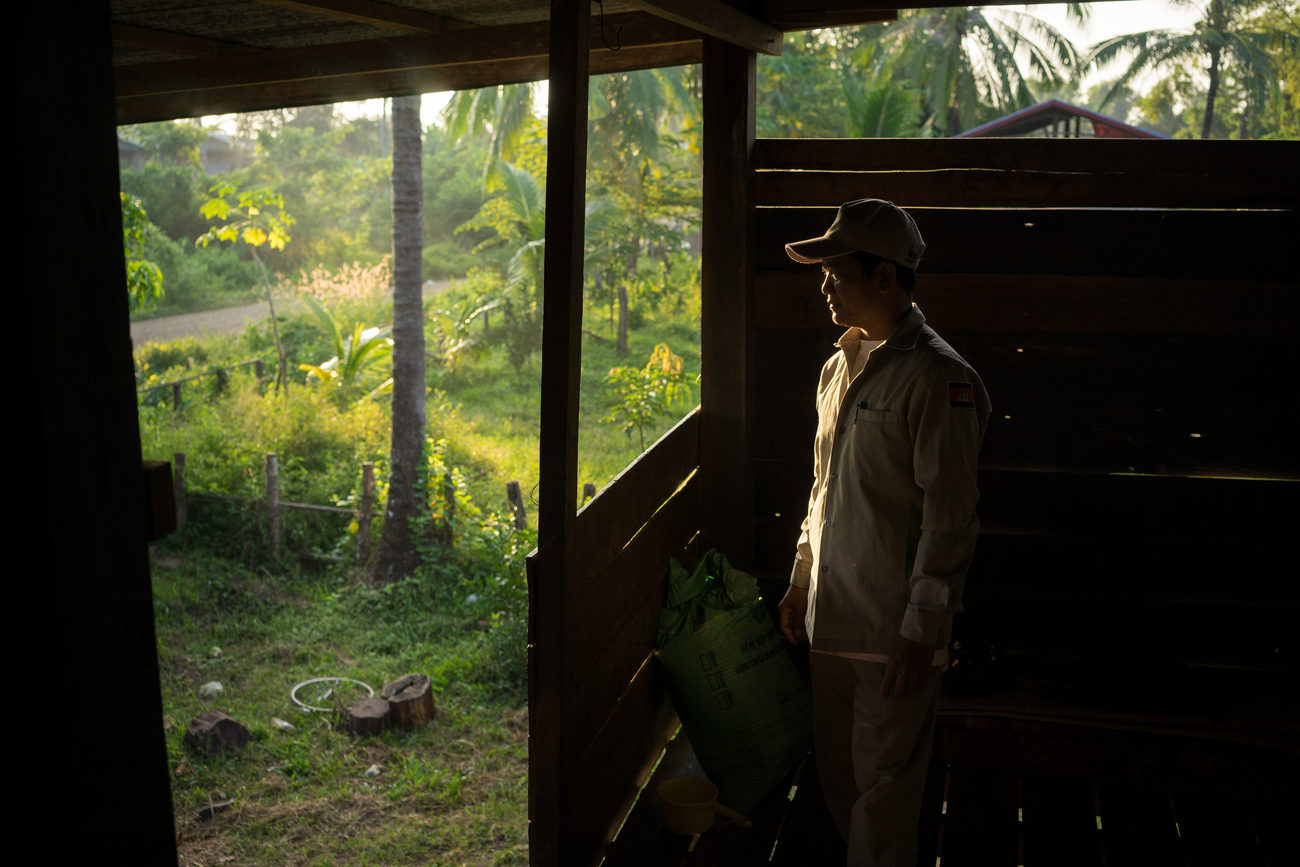
Mekong: a river in chains
November 4, 2014 - Preah Rumkel, Stung Treng (Cambodia). Dorn Bann (47), deputy head of Anlung Cheauteal River Guard Post, poses for a picture inside his house. The particular stretch of area near the Laos-Cambodia border was once the protected home of the Mekong Irrawaddy dolphins. The cacophony of noise from daily explosives used by the workers building the Don Sahong dam, has forced the dolphins into unprotected waters threatening their survival. © Thomas Cristofoletti / Ruom
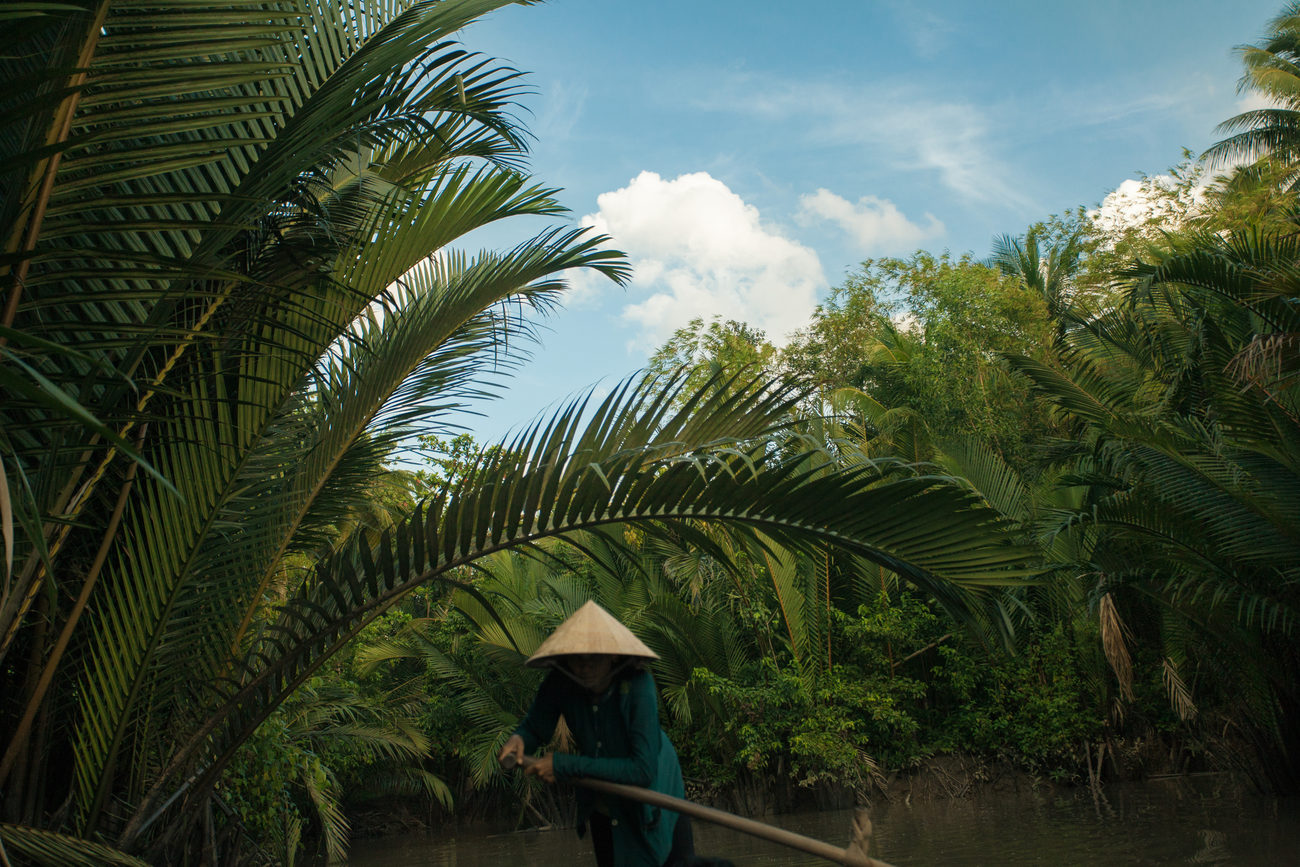
Mekong: a river in chains
August 08, 2012 - Ben Tre (Vietnam). A woman rows her boat through the intricate canals outside Ben Tre in the Mekong’s delta region. As the world's 3rd largest delta and one of the world's most important biodiversity hotspots, the Mekong Delta provides both ecological and food security for its million of inhabitants. According to International Rivers, “dams could significantly reduce fishing, restrict the flow of sediments and elements for agriculture, impact food security and jeopardize the Mekong Delta, in addition to forcing tens of thousands of inhabitants to relocate. © Thomas Cristofoletti / Ruom

Mekong: a river in chains
February 14, 2013 - Sihanoukville (Cambodia). A group of divers exercises on the shore of Independent beach. They are part of Cambodia’s first batch of salvage divers trained to recover the thousands of tons of unexploded artillery shells and bullets that lie at the bottom of the country’s lakes and rivers. A potential of 300 ships were sunk in Cambodia’s in the Mekong and Tonle Sap rivers in the 1960’s and 70’s, when the former regime received U.S. supply from South Vietnam before being toppled by the Khmer Rouge. © Thomas Cristofoletti / Ruom

Mekong: a river in chains
October 16, 2014 - Tram Chim (Vietnam). Villagers clean and pick fishes to sell to the local market. Along the Mekong’s long path, over sixty million people rely on its waters for rice crops and as a resource for the fishing industry. But in the last decades, the construction of over 39 mega dams along its pathway is putting at risk the delicate ecosystem and the livelihood of million of people. According to International Rivers, “dams could significantly reduce fishing, restrict the flow of sediments and elements for agriculture, impact food security and jeopardize the Mekong Delta, in addition to forcing tens of thousands of inhabitants to relocate. © Thomas Cristofoletti / Ruom
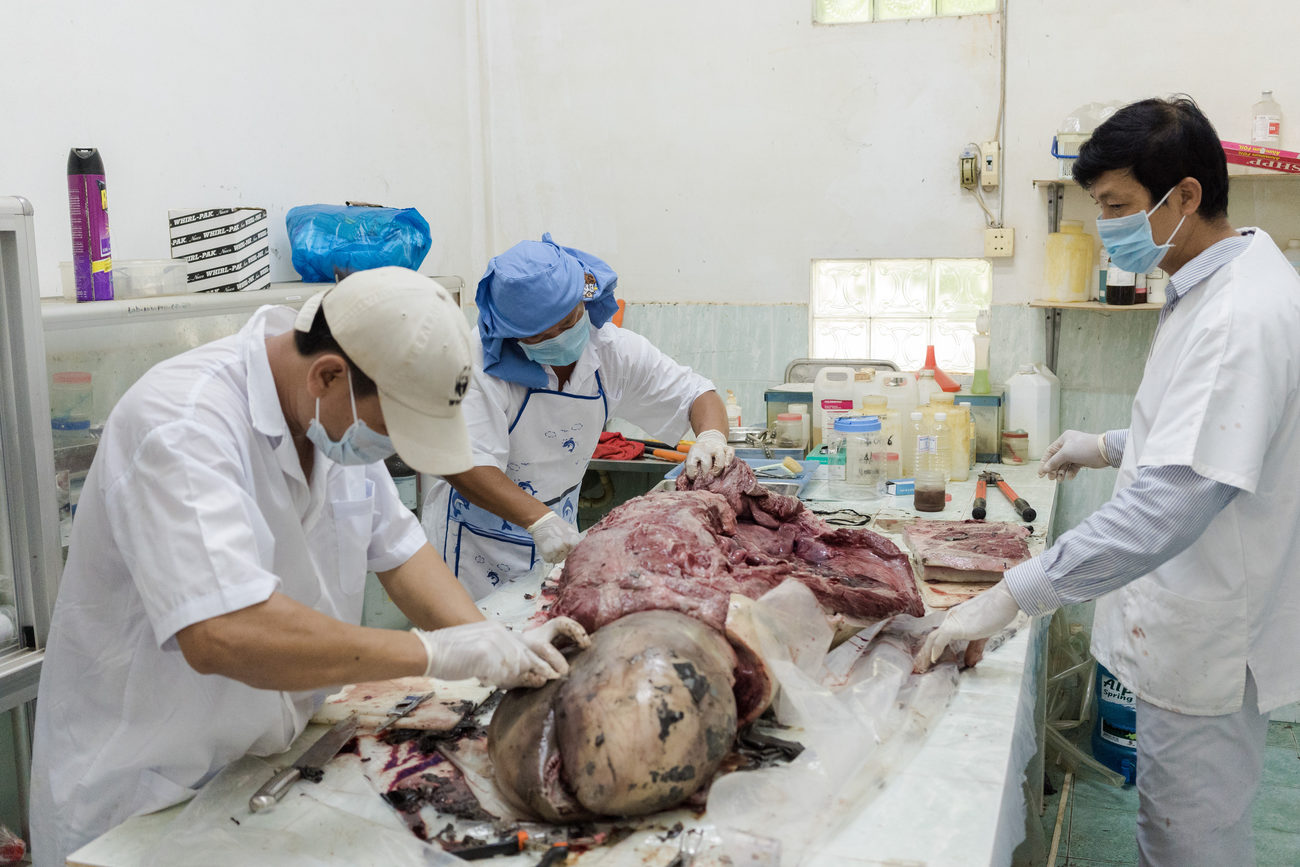
Mekong: a river in chains
August 24, 2018 - Kratie (Cambodia). A team of WWF personal performs an autopsy on the carcass of an Irrawaddy dolphin found dead on June 29th. The mammal was found by local fishermen in the protected area of Kampi and the cause of death was determined as bruising caused by an illegal fishing net. Experts say that the construction of dams will further jeopardize the ecological integrity of the Lower Mekong as a whole. In particular, it will have a severe impact on the endangered giant catfish and other fish species — some of them unique to the Mekong — like the Irrawaddy dolphin. @ Thomas Cristofoletti / Ruom

Mekong: a river in chains
December 17, 2016 - Stung Treng (Cambodia). A truck carrying logs passes through a check point inside the construction site of the Lower Sesan 2 dam. Forest monitors allege that the construction of the dam led to large-scale deforestation of protected timber in the surrounding areas. © Thomas Cristofoletti / Ruom
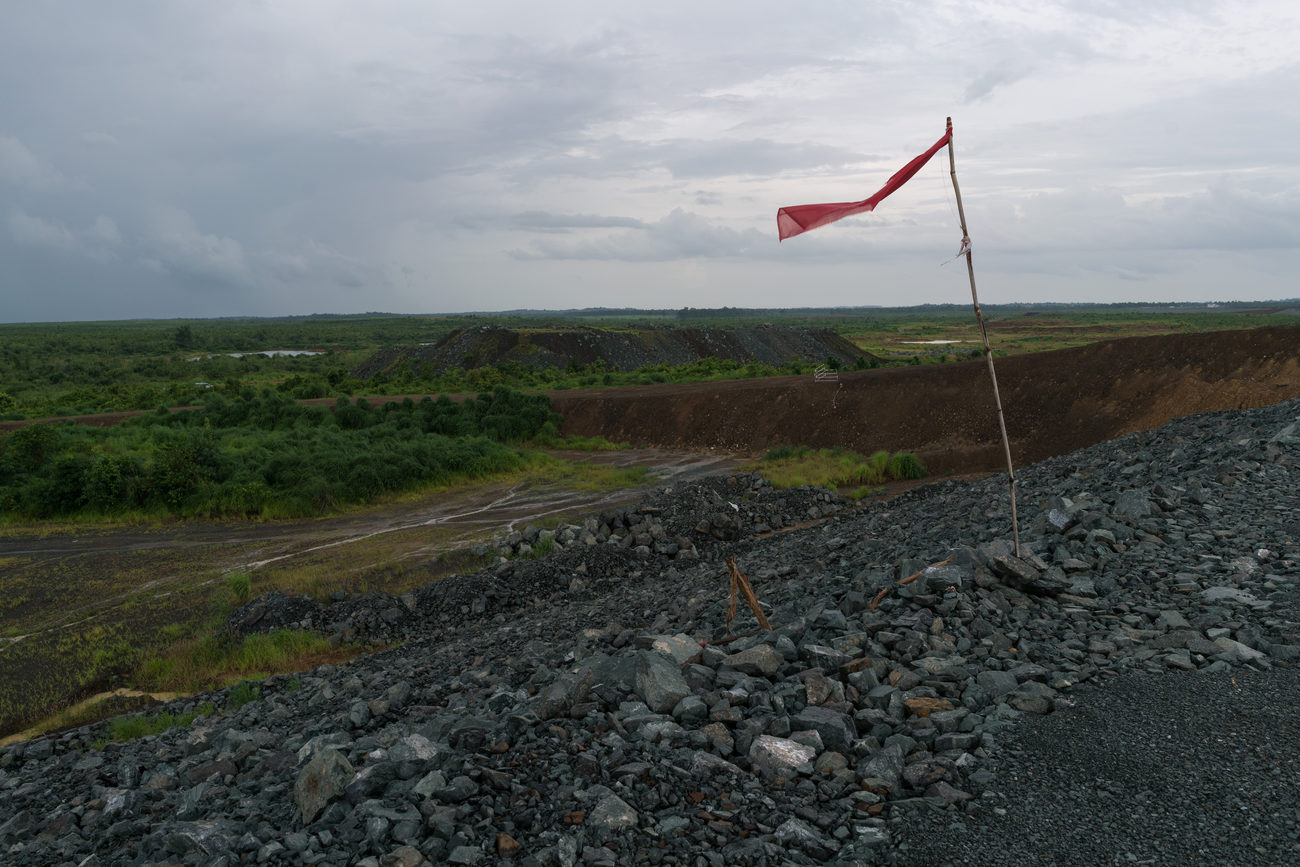
Mekong: a river in chains
August 18, 2016 - Stung Treng (Cambodia). A view of the vaste area that will be soon flooded when the construction of the Lower Sesan II dam will be finished. The 400-MW dam—a joint venture between Cambodian businessman Kith Meng and China’s Hydrolancang International Energy Co. Ltd.—is set to displace more than 5,000 villagers in Sesan district. Studies claim that the dam could seriously affect fisheries, and in turn the livelihoods of more than 100,000 residents living upstream and downstream of the dam. © Thomas Cristofoletti / Ruom
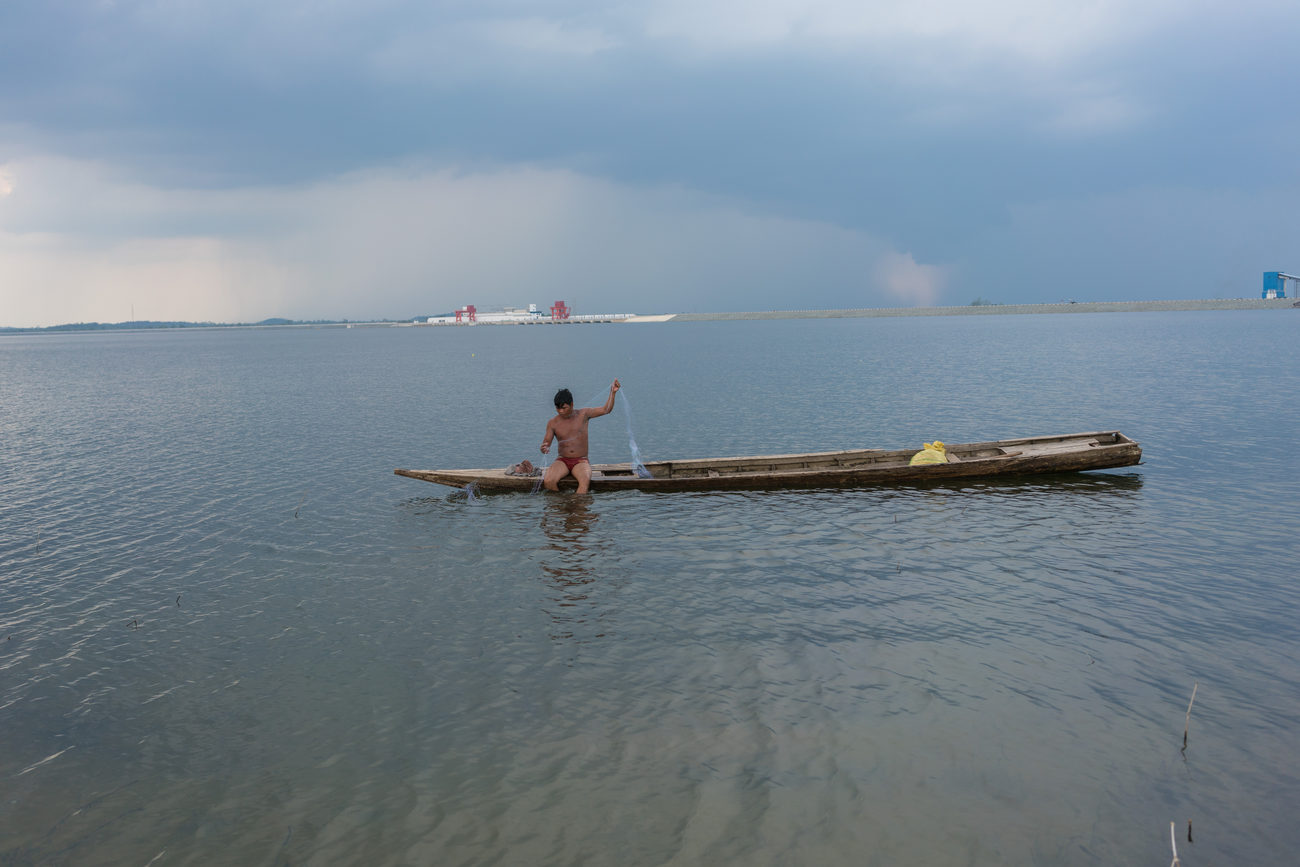
Mekong: a river in chains
April 26, 2018 - Stung Treng (Cambodia). A fisherman checks his net in the water in front of the controversial $800 million, 400-megawatt Lower Sesan II Dam built in northern Cambodia. The project, a joint venture between powerful Cambodian businessman Kith Meng’s Royal Group and Chinese state-owned Hydrolancang International Energy Co Ltd., has been controversial from the start, with experts raising concern about the environmental impact on fish stock and sediment flow, but also because of the thousand of indigenous people whose lives have forever changed when dam’s 50-megawatt turbines went into operation. © Thomas Cristofoletti / Ruom
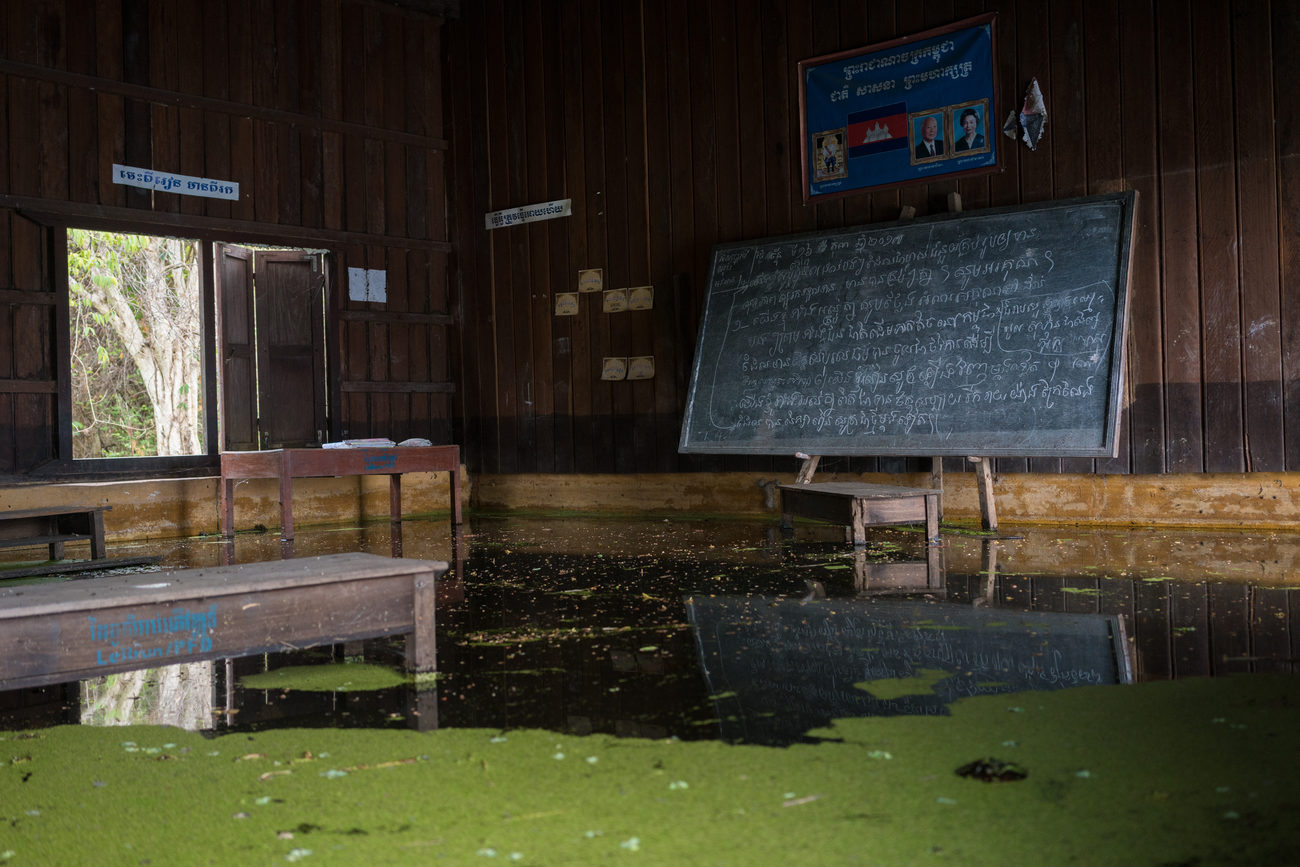
Mekong: a river in chains
April 25, 2018 - Stung Treng (Cambodia). View of one of the classroom of Kbal Romeas’ school, now flooded after the gates of the Lower Sesan 2 dam were finally closed in October 2017. Thousands of indigenous Phnong families have been forced to relocate in the process. A 2009 report, released by the NGO Rivers Coalition in Cambodia (3 years before the project was formally approved by the Cambodian government), stated that more than 38,000 inhabitants of 86 villages “would lose access to the vast majority of their fisheries resources” were the dam to be built, while 78,000 people would lose some access to fish. © Thomas Cristofoletti / Ruom
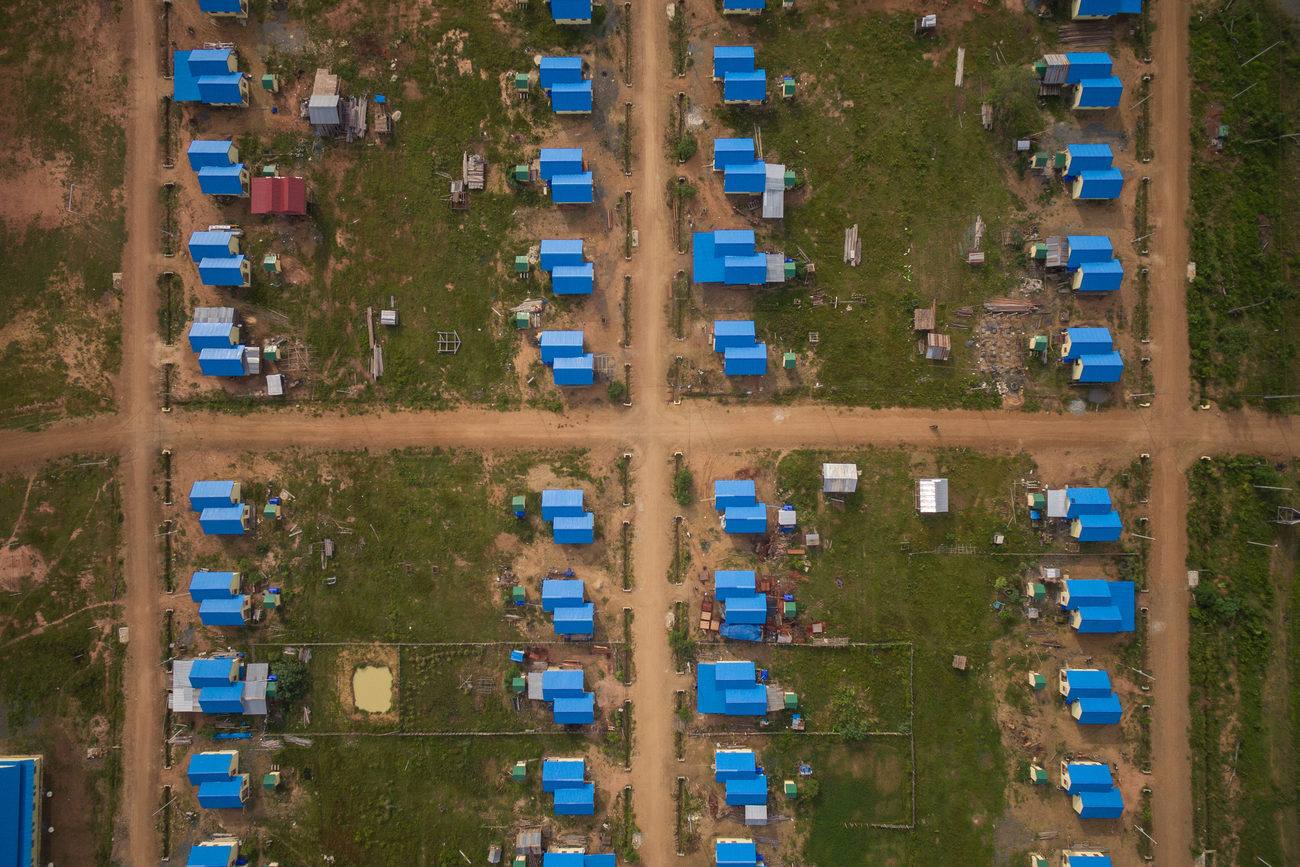
Mekong: a river in chains
August 19, 2016 - Stung Treng (Cambodia). Aerial view of the relocation village built by authorities for people that were living in the Lower Sesan 2 Dam reservoir area. The 400-MW dam—a joint venture between Cambodian businessman Kith Meng and China’s Hydrolancang International Energy Co. Ltd.— displaced more than 5,000 villagers in Sesan district. Studies claim that the dam could seriously affect fisheries, and put at risk the livelihoods of more than 100,000 residents living upstream and downstream of the dam. © Thomas Cristofoletti / Ruom
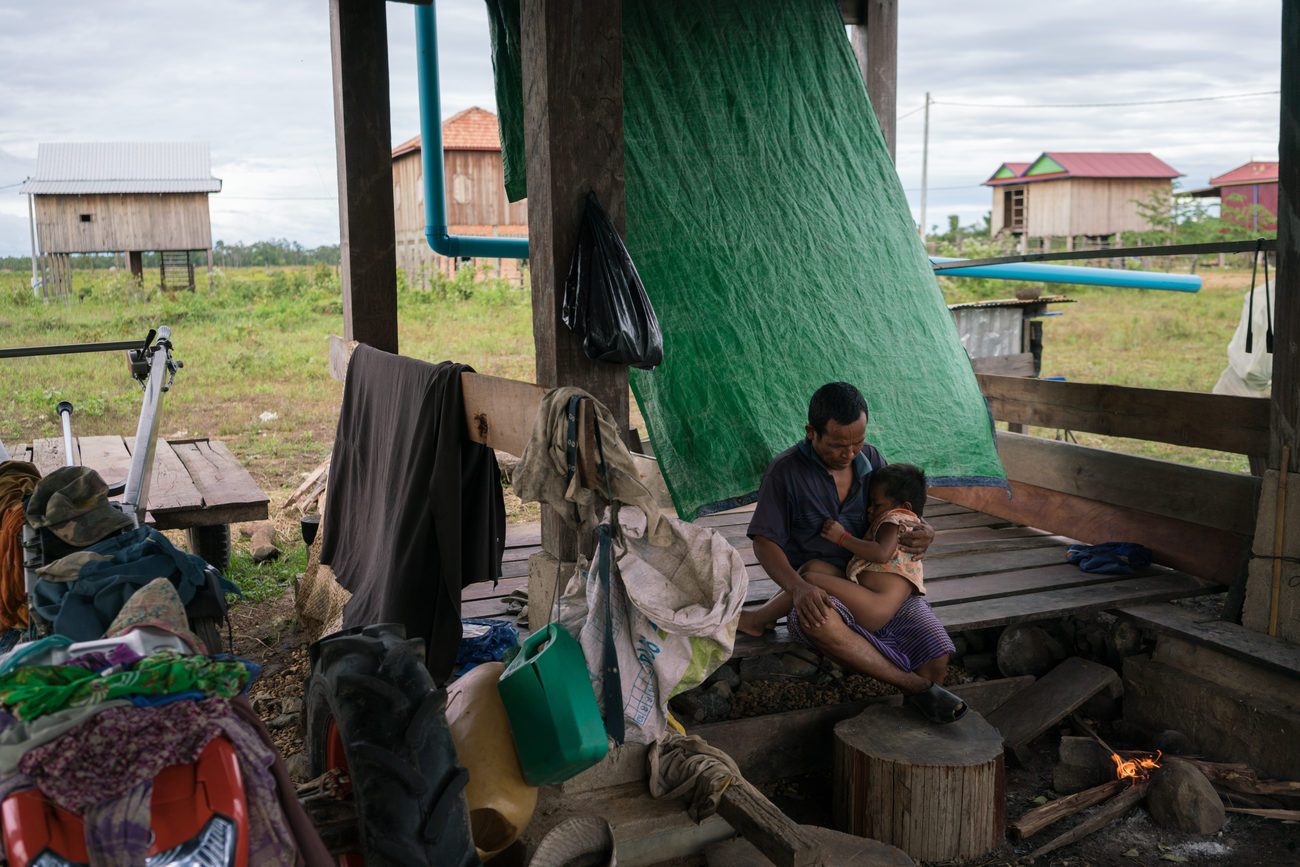
Mekong: a river in chains
Dec 16, 2016 - Srekou II Village, Cambodia. Thom Ne's husband sits with one of his children. He recently suffered a stroke and he's slowly recovering. The family was relocated from her village in Srekou to make way for the Lower Sesan II dam. They currently have no income in her new location and they already spent all the 6000 USD they received as compensation to move and renovate their house. © Thomas Cristofoletti / Ruom

Mekong: a river in chains
May 1st, 2017 - Nakasang (Laos). A group of phi bob take off running through the pond, where they must cover themselves in mud, before continuing to the banks of the Mekong, where they will swim and bathe. The phi bob is a demonic spirit that invades an individual and it is believed to proceed to cause untimely death in humans and livestock. Someone accused by their village of being a phi bob is at best socially ostracised by the community although they may also be threatened with violence or even killed – unless they can get to Nakasang. Since at least the French colonial era, the village has accepted phi bob and rehabilitated them with a special ceremony run by the local spirit mediums. © Thomas Cristofoletti / Ruom
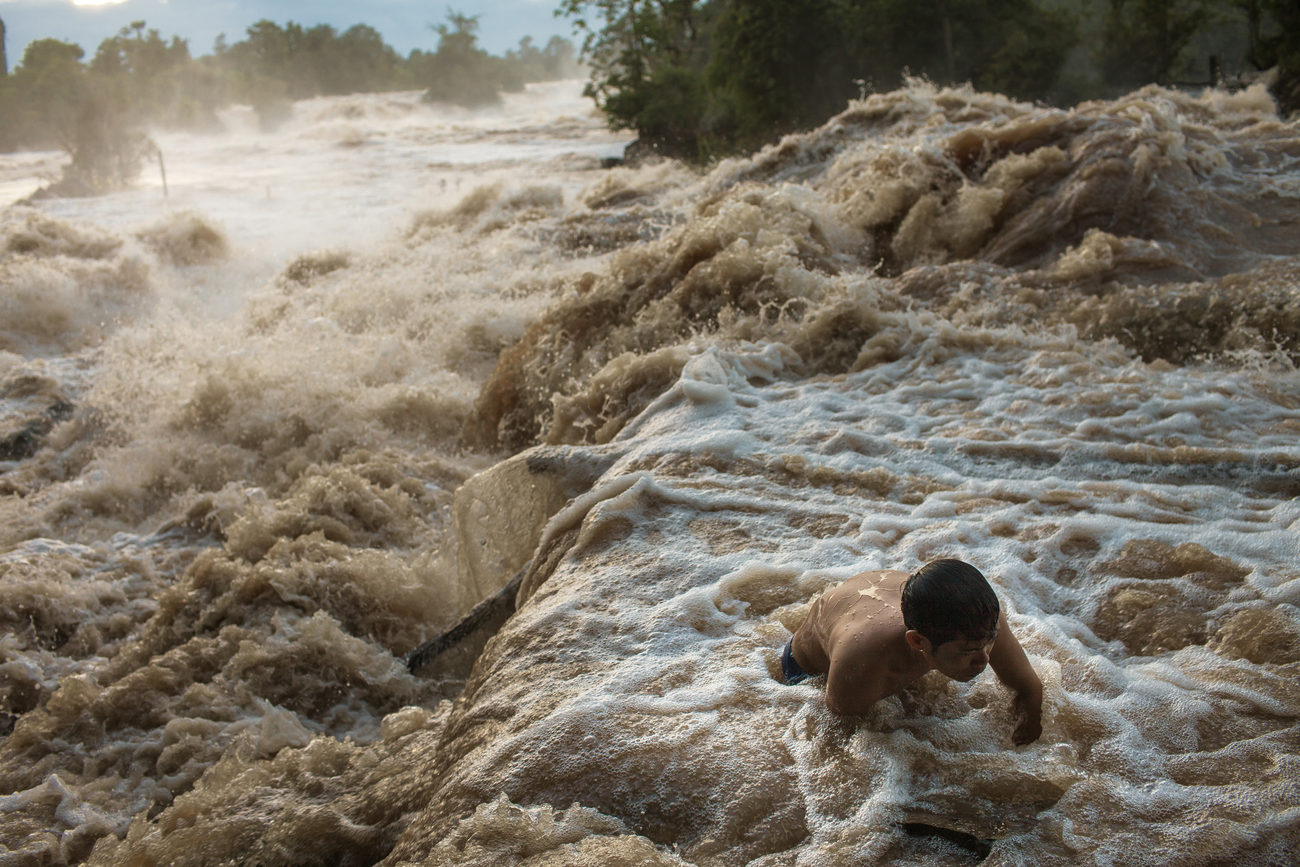
Mekong: a river in chains
August 04, 2013 - Champasak (Laos). A fisherman mends his Ly trap at the Khone Phapheng falls, the location designated for the construction of the Don Sahong Dam. Experts say that the construction of the dam will put at risk the ecological integrity of the Lower Mekong as a whole. In particular, it will have a severe impact on the endangered giant catfish, other fish species — some of them unique to the Mekong — and the Irrawaddy dolphin, which has found a natural habitat just two kilometers from the construction site and is already critically endangered. © Thomas Cristofoletti / Ruom
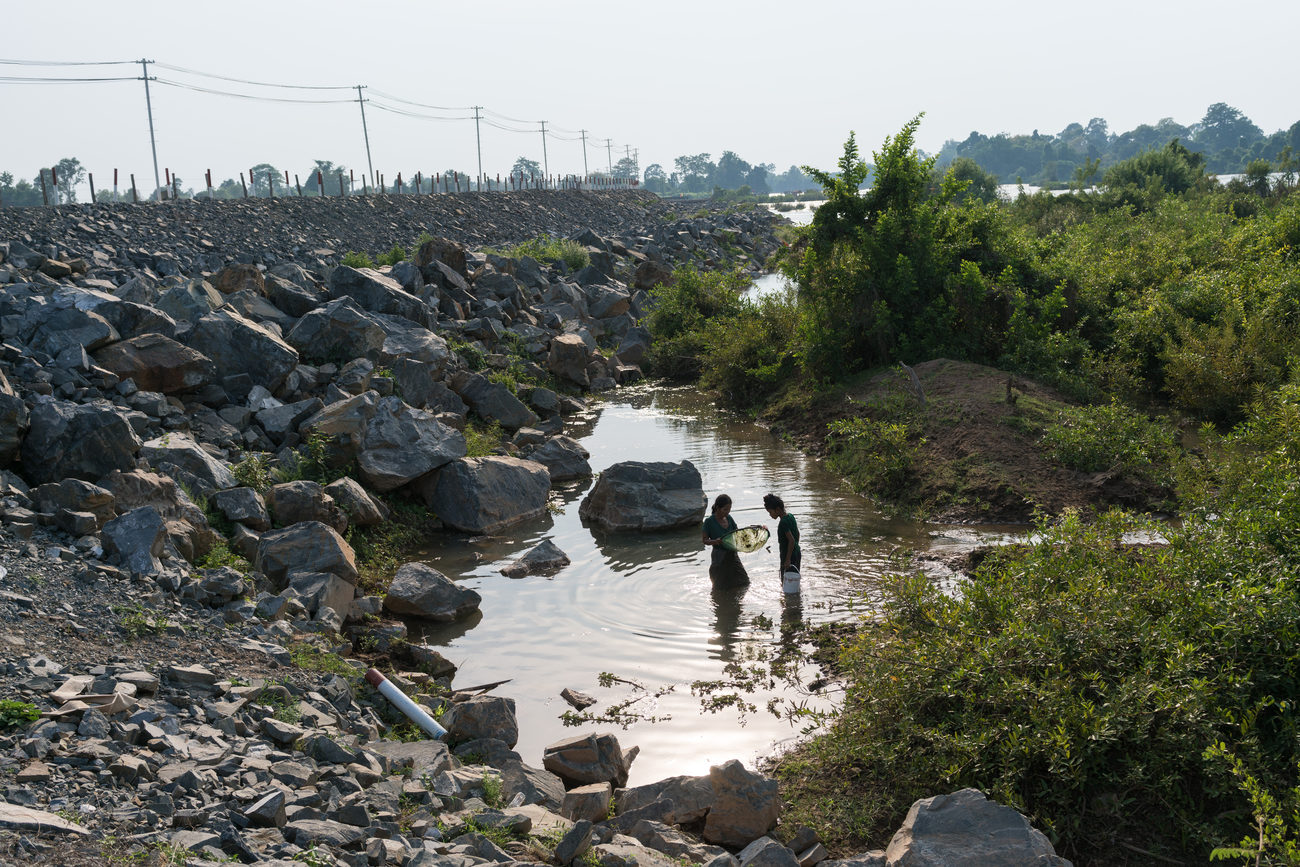
Mekong: a river in chains
May 30, 2017 - Don Sahong (Laos). A mother and her daughter catch small fishes in front of the wall built to block the water of the Don Sahong in order to prepare the 308 acres reservoir for the massive hydroelectric dam. The 260 megawatts project is set to be completed in 2019 and is located in the Siphandone (Khone Falls), less than 2 kilometers upstream of the Laos-Cambodia border. According to many experts, the dam will block the main channel passable year-round by fish migrating upstream, threatening vital subsistence and commercial fisheries in the Lower Mekong Basin. © Thomas Cristofoletti / Ruom
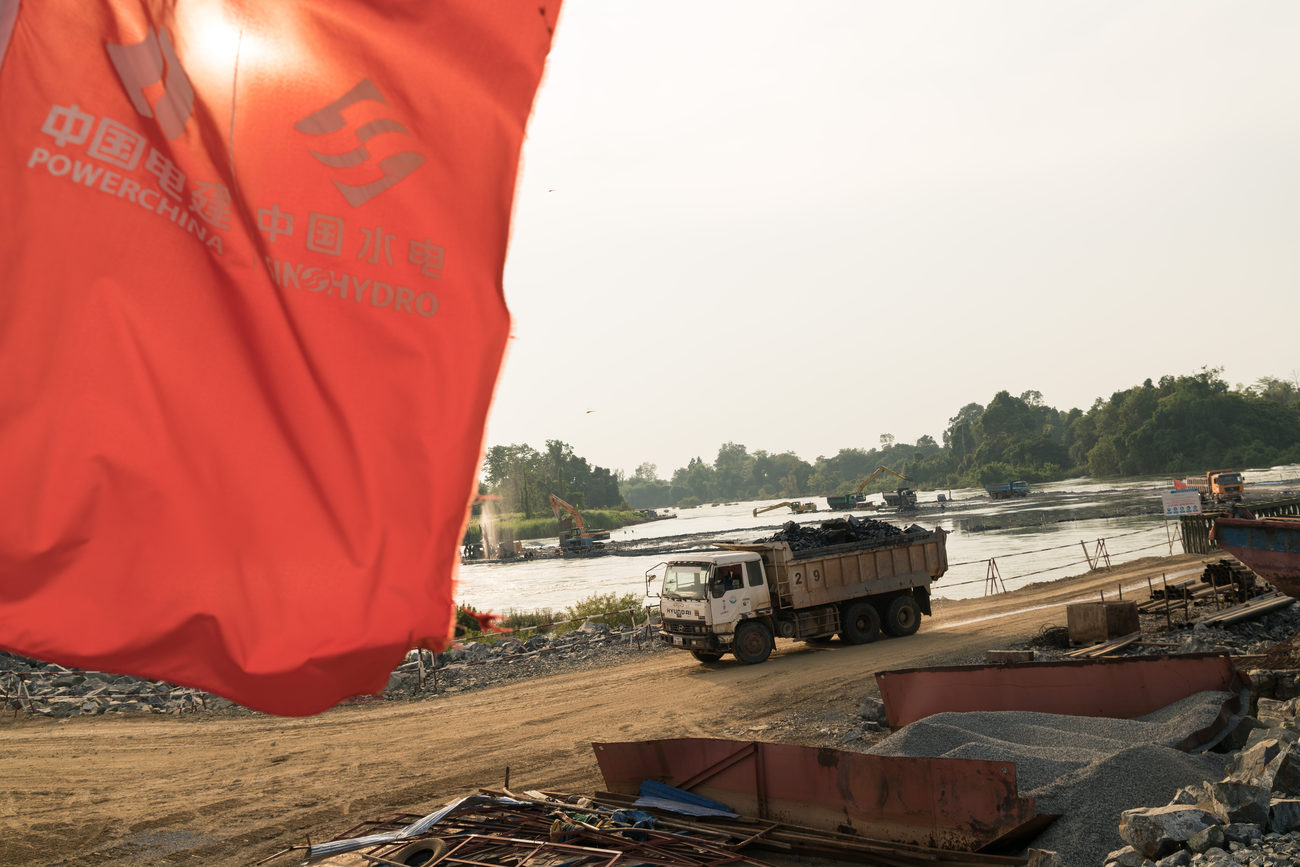
Mekong: a river in chains
May 30, 2017 - Don Sahong (Laos). A truck carries rocks inside the construction site of the Don Sahong dam on the Laos - Cambodia border. The 260 megawatts project is set to be completed in 2019 and is located in the Siphandone (Khone Falls). According to many experts, the dam will block the main channel passable year-round by fish migrating upstream, threatening vital subsistence and commercial fisheries in the Lower Mekong Basin. © Thomas Cristofoletti / Ruom
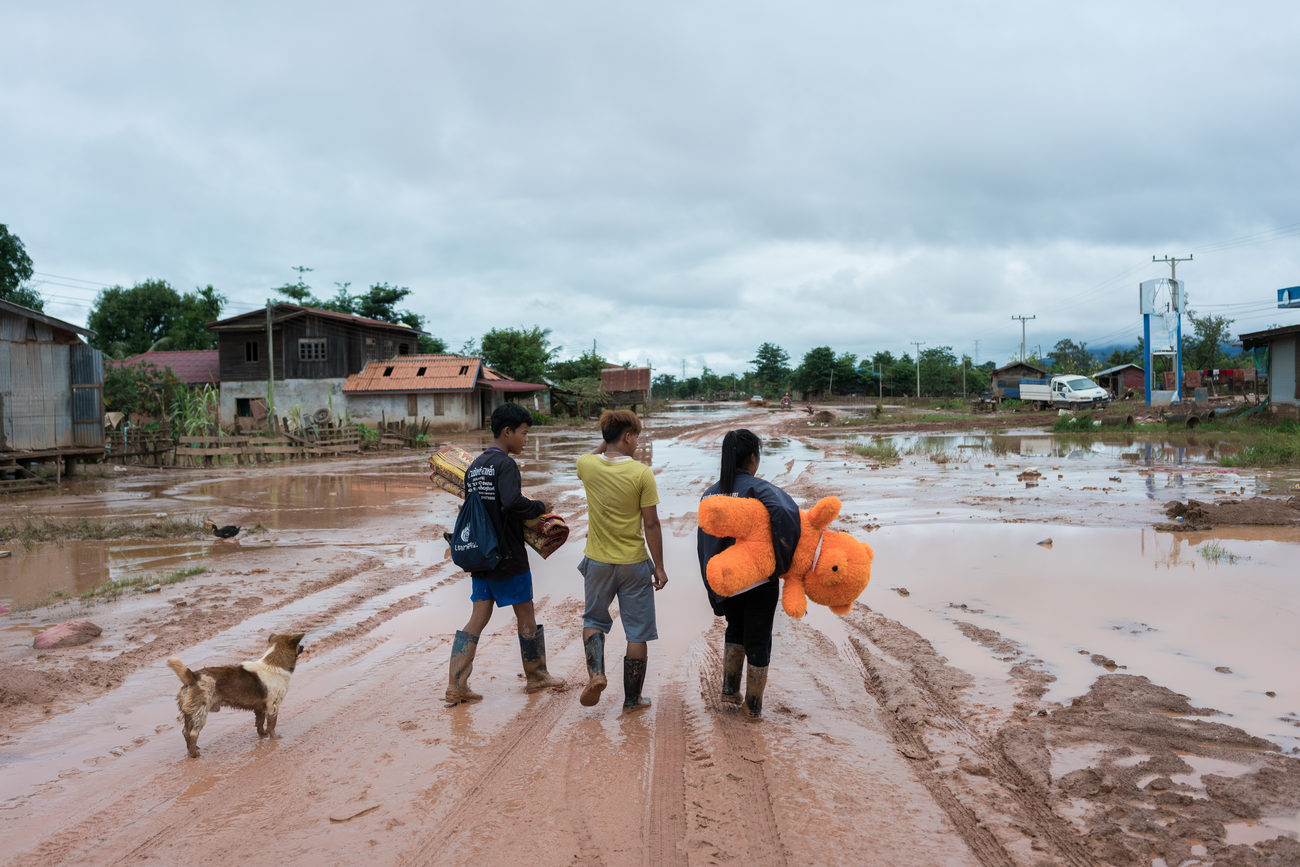
Laos Dam Collapse
August 05, 2018 - Attapeu (Laos). A group of young villagers walks through the main street of the small village of Kokkong, on the edge of area affected by the floods caused by the collapse of the Xe-Pian Xe-Namnoy dam. The village has been partially submerged but most of the houses are covered in mud but still in good condition. As of 25 September 2018, 40 people were confirmed dead, at least 98 missing and almost 7000 others were displaced and relocated in temporary camps. © Thomas Cristofoletti / Ruom

Mekong: a river in chains
August 06, 2018 - Attapeu (Laos). Aerial view of Mai village, one of the affected villages by the fury of the floods caused by the failure of an auxiliary dam of the Xe-Pian Xe-Namnoy hydropower project. According to the measurements made with an European Union’s satellite, the tide of floodwater reached 10m in the village and uprooted trees, power lines and collapsed most of the houses. 8 people lost their lives in the floods just in this village and many are still missing. © Thomas Cristofoletti / Ruom
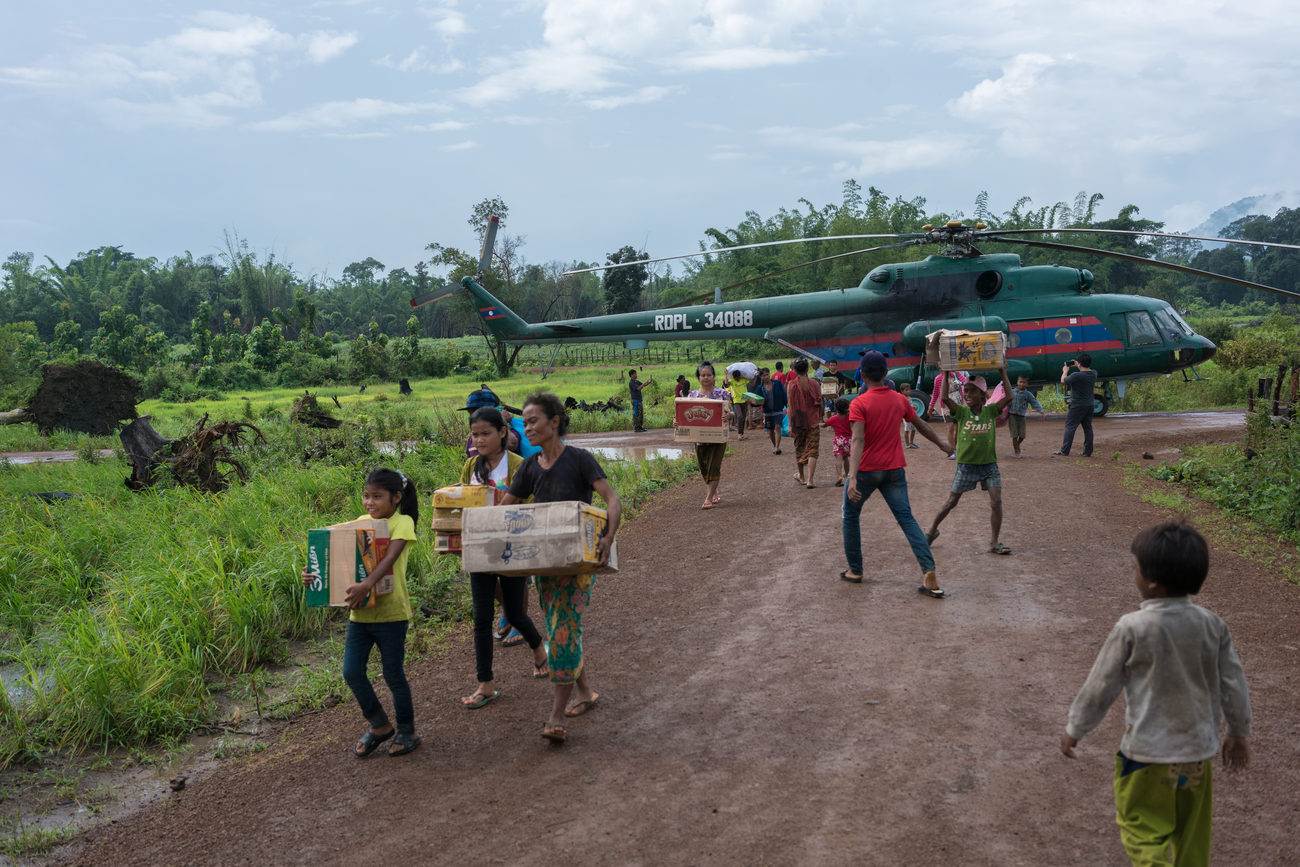
Mekong: a river in chains
August 06, 2018 - Attapeu (Laos). Food supplies and medicines are transported with an army helicopter and distributed to the people of the remote Bane Pindong village. 10 days after the collapse of the Xe-Pian Xe-Namnoy dam, most of the villages were still cut off and only reachable by air or after a dangerous drive by 4x4 vehicles or tractors. As of 25 September 2018, 40 people are confirmed dead, at least 98 missing and almost 7000 others have been displaced and relocated in temporary camps. © Thomas Cristofoletti / Ruom
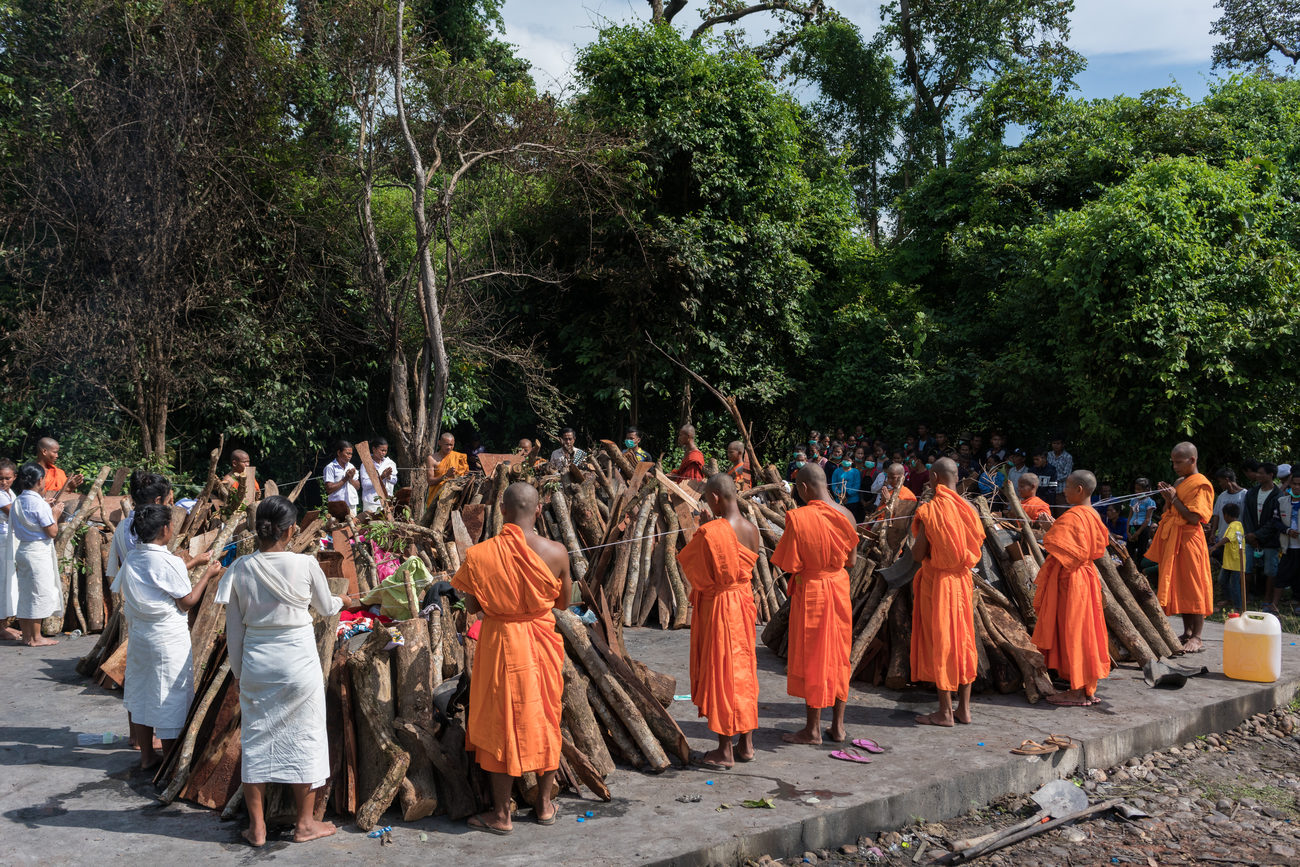
Mekong: a river in chains
August 05, 2018 - Attapeu (Laos). 6 bodies of people that lost their lives during the floods caused by the collapse of the Xe-Pian Xe-Namnoy dam, and that were recovered in the previous couple of days, are cremated during a Buddhist ceremony. As of 25 September 2018, 40 people are confirmed dead, at least 98 missing and almost 7000 others have been displaced and relocated in temporary camps. © Thomas Cristofoletti / Ruom

Mekong: a river in chains
December 27, 2015 - Phnom Penh (Cambodia). People queue for a Christmas draw at Aeon Mall, one of the biggest and more modern mall in the capital. Cambodia has undergone rapid economic development in recent decades. However, the country still lacks the infrastructure required for the energy sector to match the pace of development, especially for the capital Phnom Penh, that alone consumes 90% of Cambodia’s electricity. © Thomas Cristofoletti / Ruom
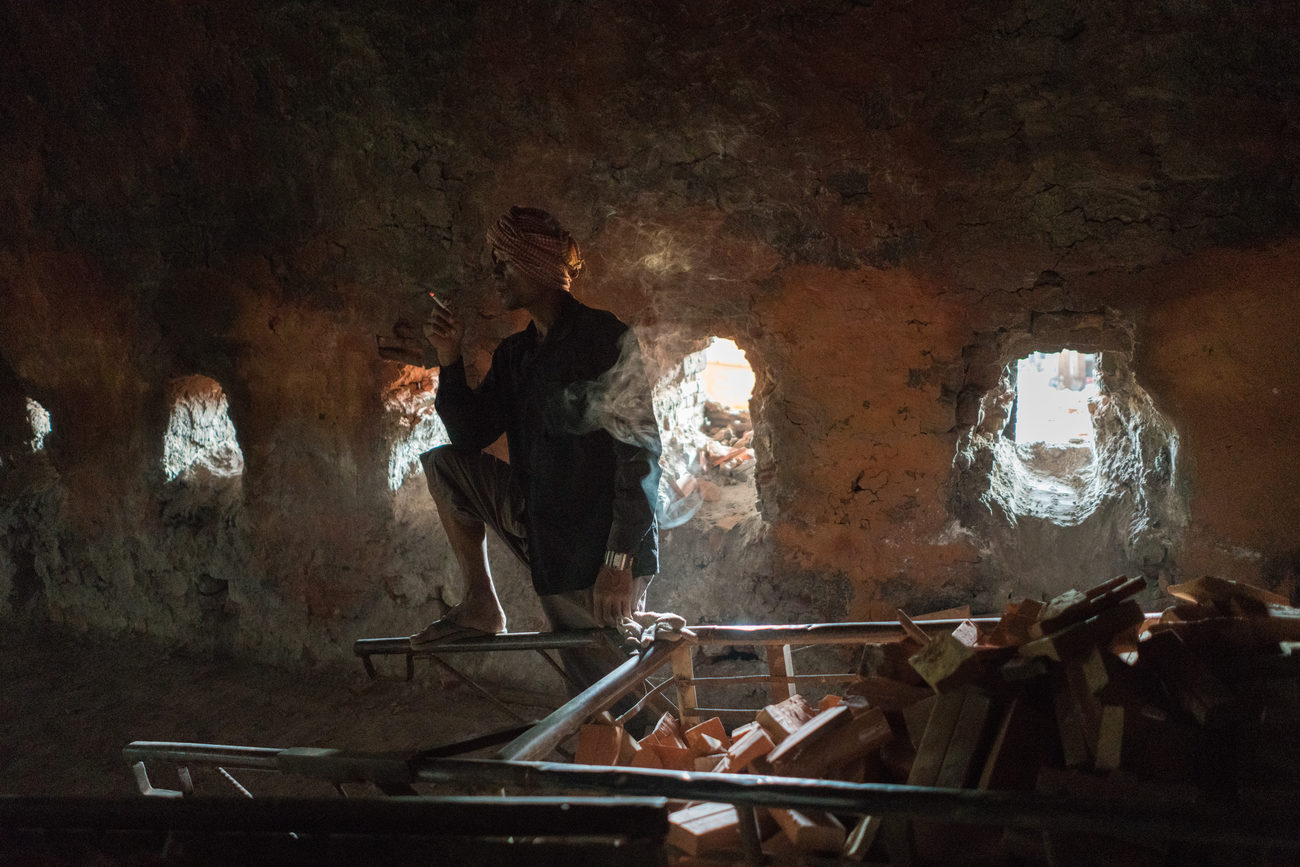
Mekong: a river in chains
December 13, 2017 - Phnom Penh (Cambodia). A worker has a cigarette break while cleaning a kiln from broken bricks and ashes. Cambodia is in the midst of a construction boom. The building of high-rise office blocks and housing is pushing the capital city upwards but the country’s vertical drive into the skies and status as one of Asia’s fastest growing economies hides a darker side to Phnom Penh’s ascent. Building projects demand bricks in large quantities and there is a profitable domestic brick production industry using multigenerational workforces of debt-bonded adults and children to supply them. © Thomas Cristofoletti / Ruom
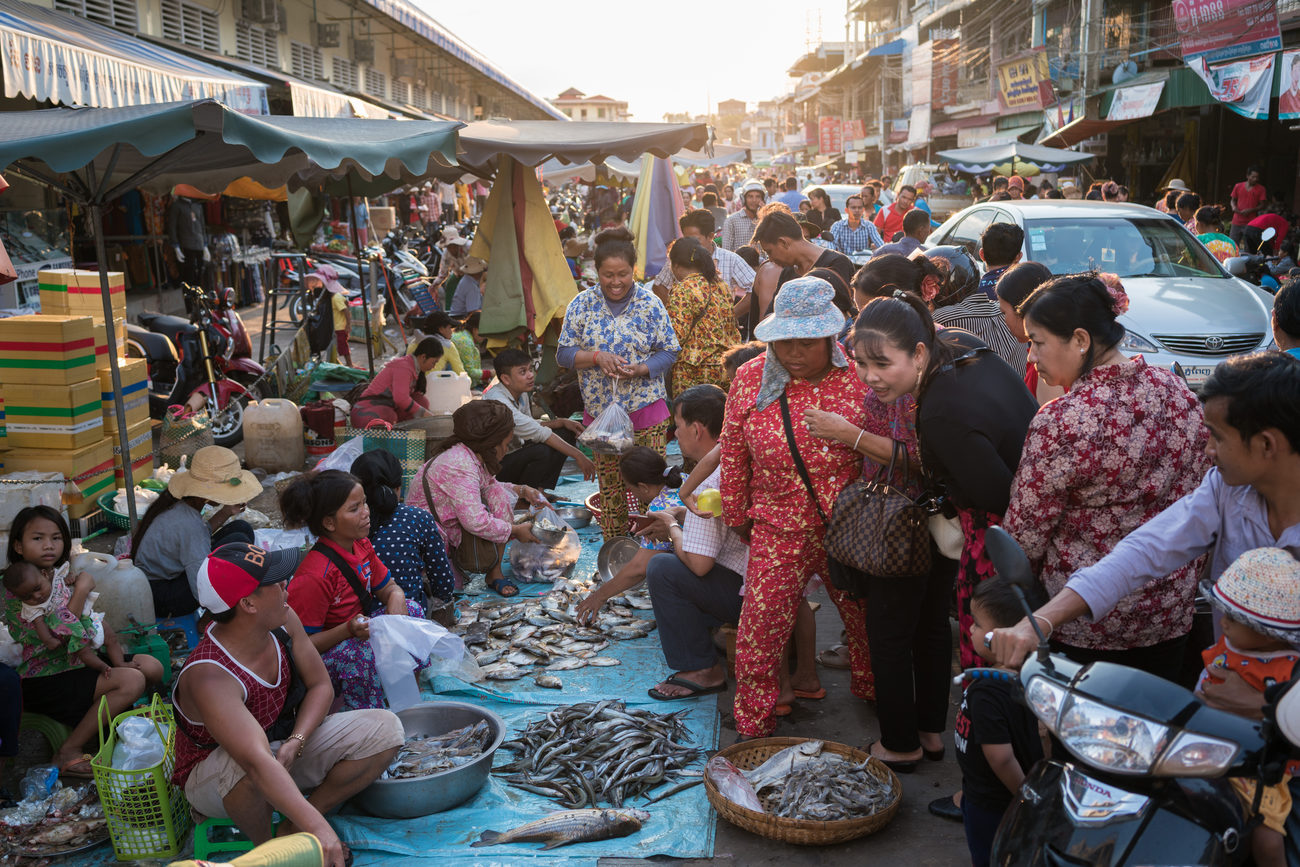
Mekong: a river in chains
April 27, 2018 - Stung Treng (Cambodia). Fish vendors at the local market of Stung Treng, located where the Mekong and Sesan rivers join together. Fish experts have long warned about damage to fishing stock due of the construction of dams like the Don Sahong and Lower Sesan 2 on the Mekong river and its tributaries. © Thomas Cristofoletti / Ruom

Mekong: a river in chains
November 22, 2018 - Phnom Penh. A Chinese man look through the windows of the gym built on the 39th floor of the Bridge, a massive mixed-developments costed around $300 million and built by the Chinese company Sino Great Wall. Cambodia has undergone rapid economic development in recent decades. However, the country still lacks the infrastructure required for the energy sector to match the pace of development, especially for the capital Phnom Penh, that alone consumes 90% of Cambodia’s electricity. © Thomas Cristofoletti / Ruom

Mekong: a river in chains
April 24, 2018 - Stung Treng (Cambodia). A solar powered light illuminates Sreui Lang (19) and her small baby in the house they rebuilt a couple of km from their ancestral village Kbal Romeas, now flooded after the gates of the Lower Sesan 2 dam were closed in October 2017. Sreui Lang belongs to one of the 58 Phnong indigenous families who decided not to leave their village and continue fighting to preserve their way of life and identity. Struggling to find clean water and surrounded by large-scale industrial plantations the families resettled to an elevated area, a couple of km away from their ancestral village. © Thomas Cristofoletti / Ruom
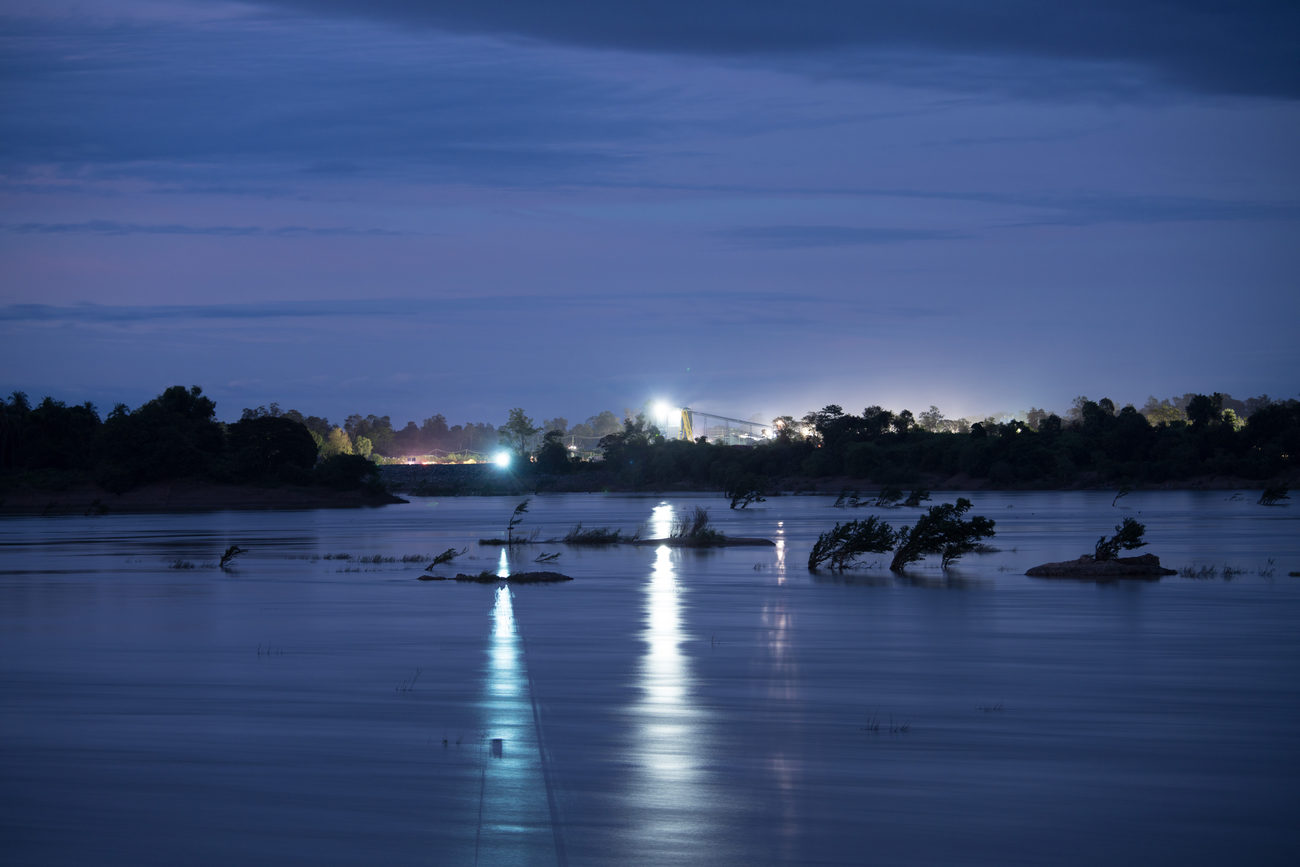
Mekong: a river in chains
Dec 15, 2016 - Preah Rumkel (Cambodia). Floodlights across the Mekong river, the particular stretch of area near the Laos-Cambodia border was once the protected home of the Mekong Irrawaddy dolphins. The cacophony of noise from daily explosives used by workers building the Don Sahong dam has forced the 3 dolphins left into unprotected waters. The 260 megawatts project is set to be completed in 2019 and is located in the Siphandone (Khone Falls). According to many experts, the dam will block the main channel passable year-round by fish migrating upstream, threatening vital subsistence and commercial fisheries in the Lower Mekong Basin. © Thomas Cristofoletti / Ruom

Mekong: a river in chains
July 19, 2018 - Phnom Penh (Cambodia). A single window has seen lit in newly built condominium in central Phnom Penh. In the last years, Cambodia’s real estate sector has seen a boom in high-end investment especially by Chinese buyers and has stoked concerns that they are pumping up a market in a country where the median household income is only around $11,000 per year. Half of the buyers are Chinese and most of the purchases are made for investment purposes by people who neither live in Cambodia nor rent the units. © Thomas Cristofoletti / Ruom
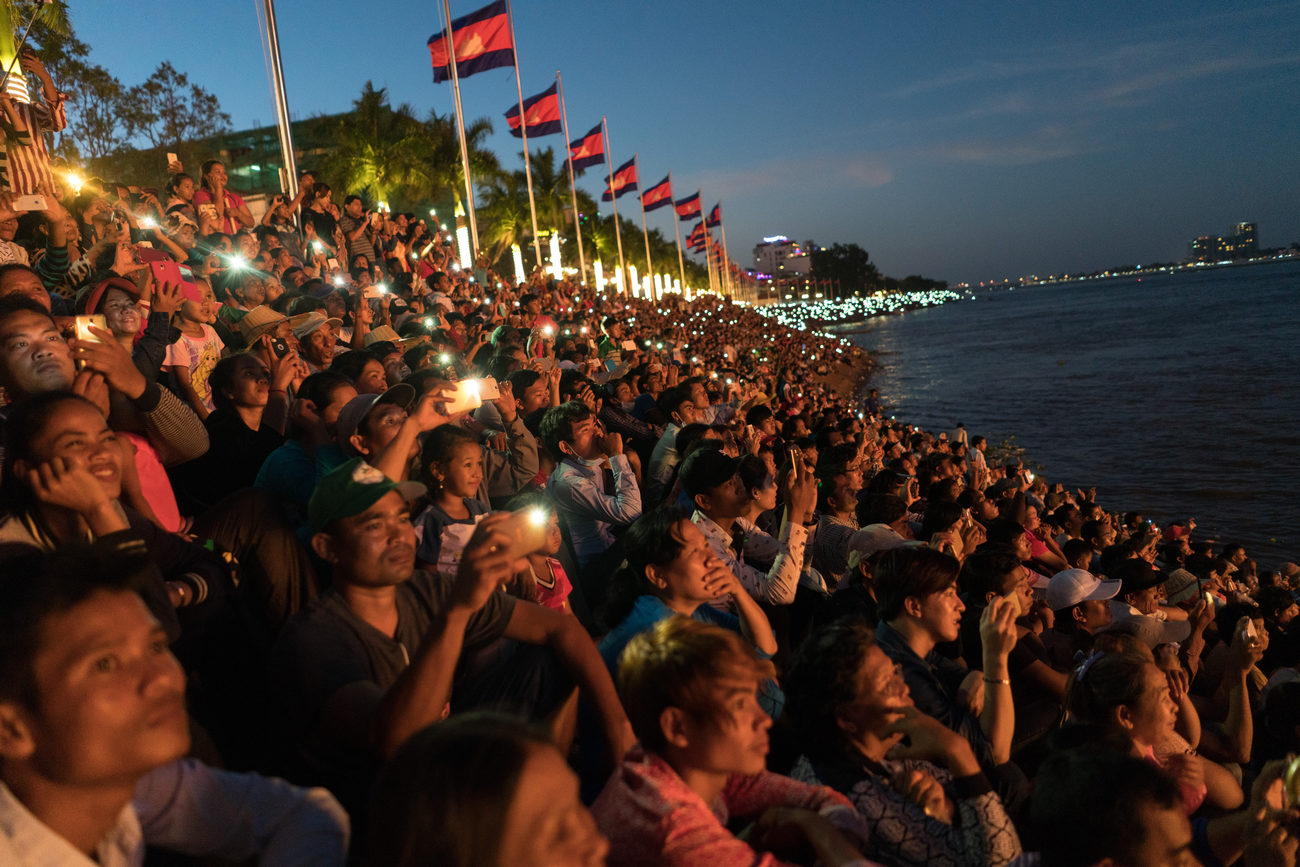
Mekong: a river in chains
November 15, 2016 - Phnom Penh (Cambodia). Thousands of people gather on the river banks to enjoy a firework show for the closing ceremony of the water festival. “Bon Om Touk” or the Water Festival, is a Cambodian festival celebrated in November and marks the unique reversal of the flow of the Tonle Sap River (one of the Mekong’s tributaries) Visitors from every Cambodian province travel to Phnom Penh to watch boat races and attend free concerts and fireworks shows. © Thomas Cristofoletti / Ruom
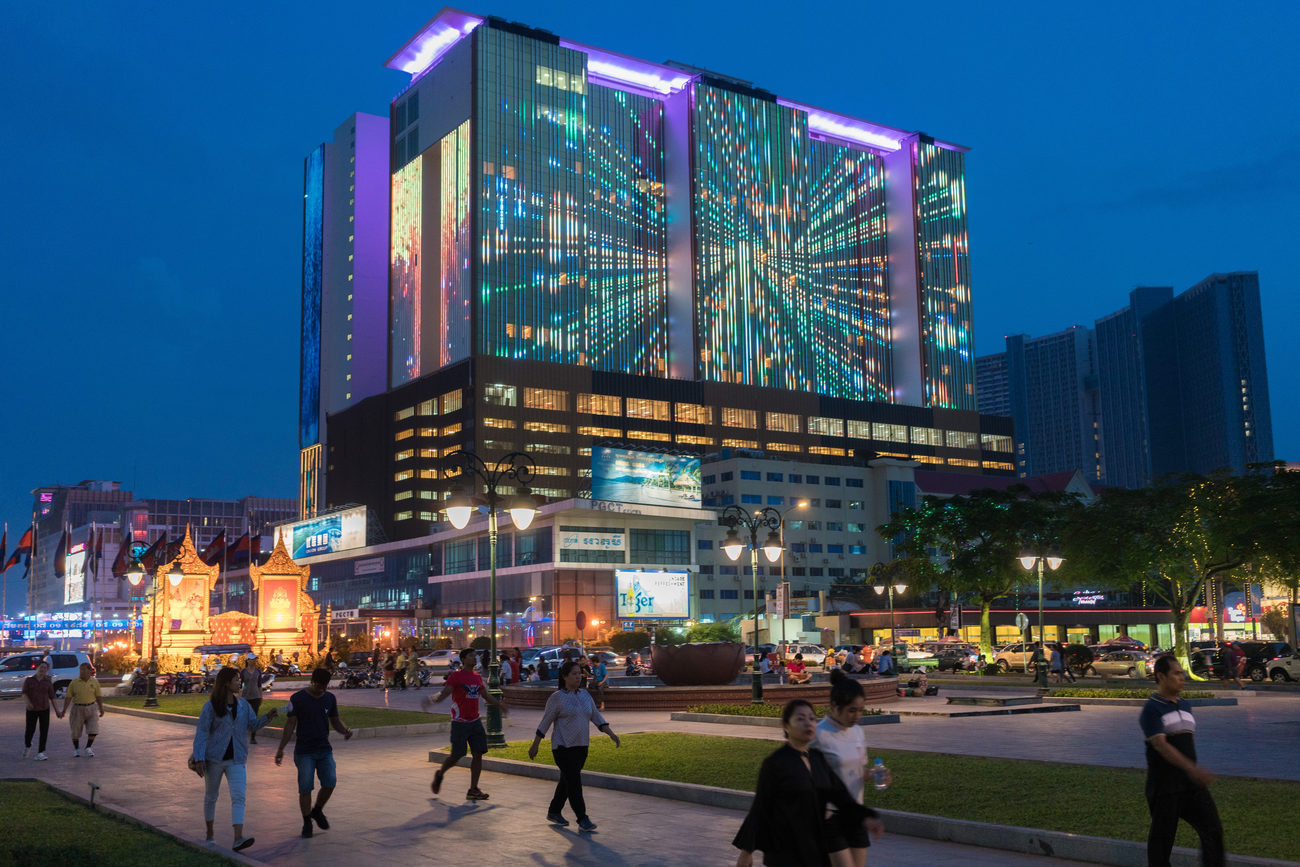
Mekong: a river in chains
January 05, 2018 - Phnom Penh (Cambodia). Locals enjoy an evening stroll at "Hun Sen Park" in central Phnom Penh. Behind them, the building of "Naga World 2" - the only casino licensed to operated in the Cambodian capital. Owned by the Malaysian multi-billioner Chen Lip Keong, the casino specifically targets Chinese clients. Cambodia has undergone rapid economic development in recent decades. However, the country still lacks the infrastructure required for the energy sector to match the pace of development, especially for the capital Phnom Penh, that alone consumes 90% of Cambodia’s electricity. © Thomas Cristofoletti / Ruom